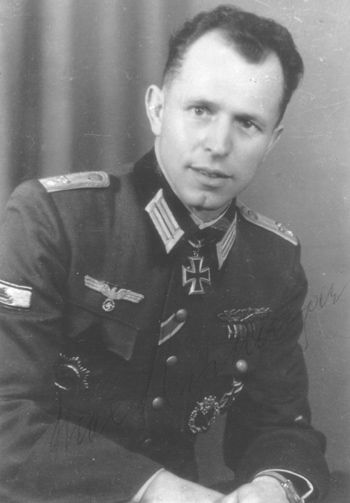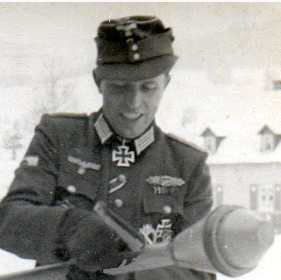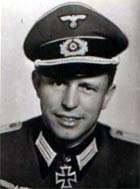Haschberger, Max (Grenadier-Regiment 481)
- Date of birth:
- July 29th, 1913 (Neudek/Eger, Austria-Hungary)
- Date of death:
- January 15th, 2002 (Regensburg, Germany)
- Nationality:
- German
Biography
From 1935 to 1937 he served in the Czechoslovak 26th Infantry Regiment and reached the rank of NCO.
After the occupation of the Sudetenland by Germany he entered in July 26, 1939 as Schütze I. Bataillon, Infanterie-Regiment 481 in Sulzbach-Rosenberg. He was most likely from August to October 1939 in the Protectorate of Böhmen und Mähren, then he was deployed in May and June 1940 in the line-up of the 256th Infanterie-Division in the campaign in the West.
After hard fighting he received in Dunkerque Kriegsverdienstkreuz.
After the campaign his division was as occupation in St. Malo and 10.12.1940 was moved to East Prussia.
At the beginning of the war against the Soviet Union, Unteroffizier Haschberger served in the 3rd Kompanie, Infanterie-Regiment 481, 256. Infanterie-Division
22.6.1941: deployed in the middle section of the Eastern Front.
Despite several minor injuries, he remained with the unit.
During the winter of 1941-1942 he received Eiserne Kreuz 2nd Class, Eiserne Kreuz 1st Class, Infanterie-Sturmabzeichen in Silber and Ostmedaille für den Winterschlacht 1941/42.
July 28, 1942: he destroyed his first Russian tank in close combat. For the other destroyed tanks he received Ärmelstreifen für die Panzernahbekämpfung.
August 1, 1942 was promoted to the rank of Feldwebel and received the 5 April 1943 as platoon commander in the 3rd Kompanie, Grenadier-Regiment 481 the Deutsche Kreuz in Gold.
After his fifth injury he received July 1, 1943 as Oberfähnrich Verwundetenabzeichen in Gold and Nahkampfspange in Silber and was deployed as an Ordonnance Officer I. Bataillon, Grenadier-Regiment 481.
During heavy defensive fighting at the Vjazma in August 1943, when his division was heavily pushed by an attacking enemy , Oberfähnrich Haschberger gathered the men of the staff and supported the retreating infantrymen. Despite being wounded, he occupied Hill 237.2 at the head of his men. Destroyed in close combat four tanks T-34 and won 40 prisoners.
At night, they repelled other Russian attacks supported by tanks and only the next day were they strengthened by men from the Divisions-Bataillon 256 and Pionier-Bataillon 256 supported by several assault and cannons.
Oberfähnrich Haschberger was sent to a hospital in Zichenau. August 27, 1943 received as Oberfähnrich and ordnance officer of the I. Bataillon, Grenadier-Regiment 481, 256. Infanterie-Division the Ritterkreuz des Eisernen Kreuzes. This award was awarded to him on September 7, 1943 in the hospital. In addition, he was promoted to the rank of Leutnant from 1.8.1943.
After healing, Leutnant Haschberger came in October 1943 as commander of the 3rd Kompanie, Grenadier-Regiment 481 again on the Eastern Front. In the fighting in December 1943 he was badly wounded and after four months in the hospital in Karlovy Vary came back to his unit on the Eastern Front, November 1, 1944 he was promoted to the rank of Oberleutnant and commanded 3. Kompanie, Grenadier-Regiment 481.
After another injury he came from the hospital as commander of the 2nd Kompanie, Grenadier-Regiment 476 on the Western Front.
He fought to defend Aachen and the Hagenau Forest. Even in November 1944 he was entrusted with the command of I. Bataillon, Grenadier-Regiment 476, but the 30.11.1944 he was seriously injured and sent to the hospital in Landau.
In February 1945 he came still untreated to Ersatztruppenteil in Leitmeritz and April 20, 1945 was promoted to the rank of Hauptmann.
After the end of the war he returned to Kalrovy Var, where he was arrested on June 16, 1945 by the Czechs.
After 13 months he fled in July 1946 and got into the American zone.
Do you have more information about this person? Inform us!
- Period:
- Second World War (1939-1945)
- Rank:
- Feldwebel (Staff Sergeant)
- Unit:
- 3. Kompanie, I. Bataillon, Grenadier-Regiment 481, 256. Infanterie-Division, Heer
- Awarded on:
- April 5th, 1943
- Period:
- Second World War (1939-1945)
- Rank:
- Oberfähnrich (Sergeant 1st Class)
- Unit:
- Ordnanz-Offizier, I. Bataillon, Grenadier-Regiment 481, 256. Infanterie-Division, Heer
- Awarded on:
- August 27th, 1943
Without waiting for heavy weapon support, he launched an attack into the Soviet flank and succeeded in bringing the tank-supported hostile attack to a halt while sealing off the penetration. Despite having been wounded by this stage, he managed to fend off the subsequent Soviet ripostes against his blocking position and was even able to retake the recently lost Hill 237.2, of great importance to the German defenses in the area. 4 T-34s knocked out in close combat and 40 prisoners were the visible results of this success.
However the prisoner count actually outnumbered the men in Haschberger’s own unit, and remained an ever-present danger as they could not be taken to the rear. As such 2 men had to guard them at all times. The situation on Hill 237.2 meanwhile appeared to be hopeless. The Division had become aware of the success of Haschberger’s thrust and had promised relief, however in the meantime Haschberger would have to repel all enemy attacks against his position for a day and night, a task made no easier by the fact that he had already sustained four wounds.
The 18 German soldiers and their 40 prisoners were encircled while in their trenches on the hill. After a gruelling night the men saw tanks once again approach the hill. Recognizing the only possible course of action, Haschberger told his men that he had called down artillery fire on their own positions and that they had to take cover. Both sides took heavy fire, however the Russian tanks were persuaded into falling back along with their escorting infantry. A few hours later the Divisions-Bataillon 256 and the Pionier-Bataillon 256 (reinforced with Sturmgeschütze) finally reached the hill and firmly restored the old German line.
All the men of Haschberger’s scratch unit had been wounded to some extent, however they had achieved a remarkable victory. Generalleutnant Danhauser, the divisional commander, would later come to visit Haschberger at the main dressing station to congratulate him on his steadfastness. When he asked which of his troops had especially distinguished themselves, Haschberger responded, “All of them Herr General, otherwise we wouldn’t be alive.”
As such all of the men in Haschberger’s unit were decorated for bravery while at the main dressing station. Haschberger himself would subsequently be awarded the Knight’s Cross.
- Period:
- Second World War (1939-1945)
- Rank:
- Schütze (Private/Rifleman)
- Unit:
- I. Bataillon, Infanterie-Regiment 481
- Awarded on:
- June 1940
- Period:
- Second World War (1939-1945)
- Rank:
- Unteroffizier (Junior Officer)
- Unit:
- 3. Kompanie, Infanterie-Regiment 481
- Awarded on:
- October 1941
- Period:
- Second World War (1939-1945)
- Rank:
- Unteroffizier (Junior Officer)
- Unit:
- 3. Kompanie, Infanterie-Regiment 481
- Awarded on:
- December 1941
- Period:
- Second World War (1939-1945)
- Period:
- Second World War (1939-1945)
- Rank:
- Unteroffizier (Junior Officer)
- Unit:
- 3. Kompanie, Infanterie-Regiment 481
- Awarded on:
- February 1942
- Period:
- Second World War (1939-1945)
- Rank:
- Unteroffizier (Junior Officer)
- Unit:
- 3. Kompanie, Infanterie-Regiment 481
- Awarded on:
- July 1942
- Period:
- Second World War (1939-1945)
- Rank:
- Unteroffizier (Junior Officer)
- Unit:
- 3. Kompanie, Infanterie-Regiment 481
- Awarded on:
- July 28th, 1942
- Period:
- Second World War (1939-1945)
- Rank:
- Oberfähnrich (Sergeant 1st Class)
- Unit:
- 3. Kompanie, Infanterie-Regiment 481
- Awarded on:
- July 1st, 1943
- Period:
- Second World War (1939-1945)
- Rank:
- Oberfähnrich (Sergeant 1st Class)
- Unit:
- 3. Kompanie, Infanterie-Regiment 481
- Awarded on:
- July 1st, 1943
Sources
- Photo:
- Hauptmann der Reserve Max Haschberger | Plzeňský občasník o kultuře a historii
- - BARTL, ANTON W. & VERSTRAETEN, BART, Die Ritterkreuzträger des Sudetenlandes: 1939-1945, Wolfgang Historica, 2015.
- FELLGIEBEL, W.P., Elite of theThird Reich, Helion & Company Limited, Solihull, 2003.
- Die Ordensträger der Deutschen Wehrmacht - Haschberger, Max : H















